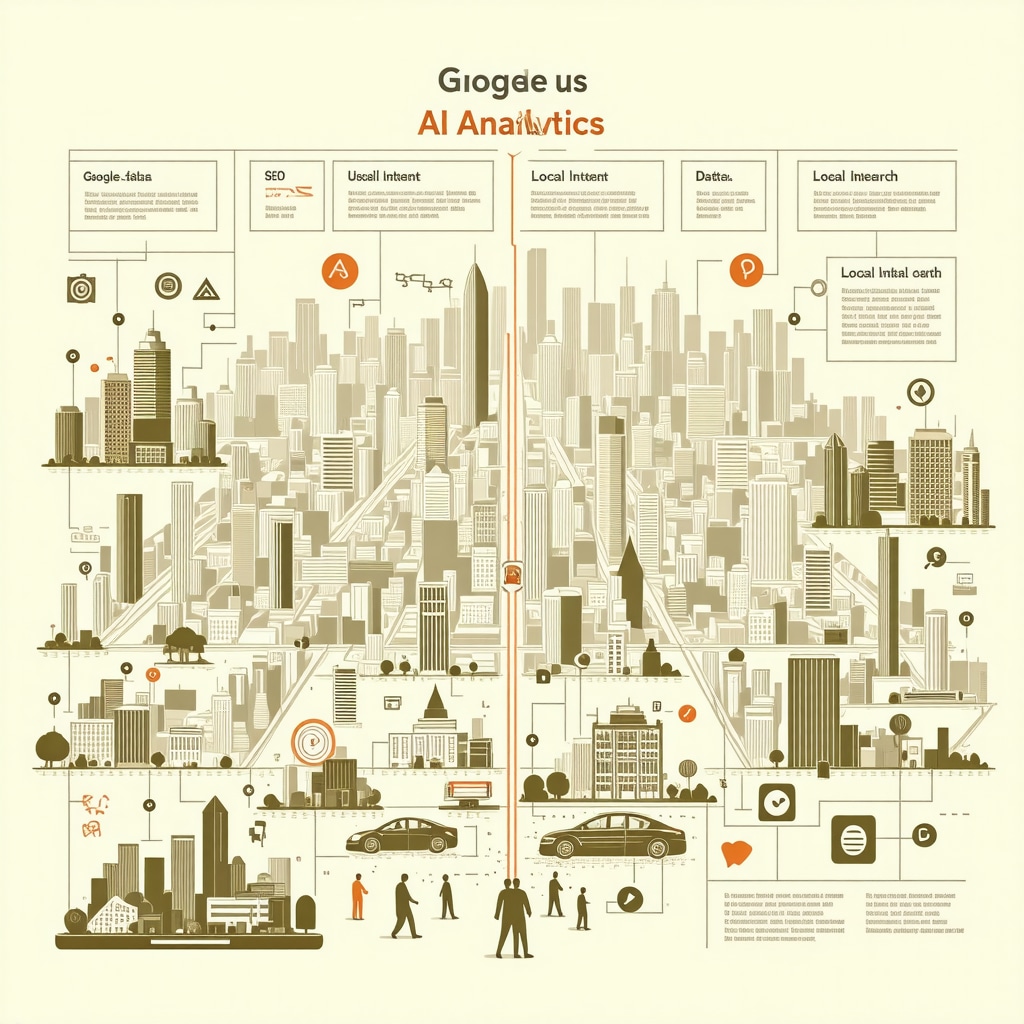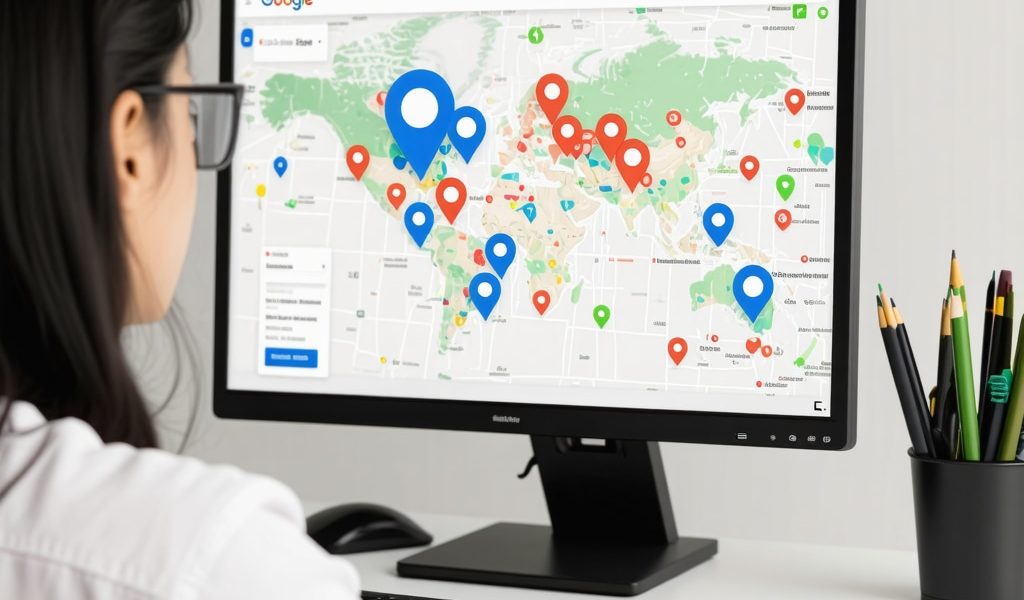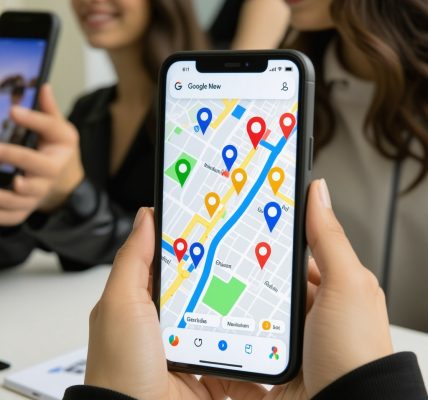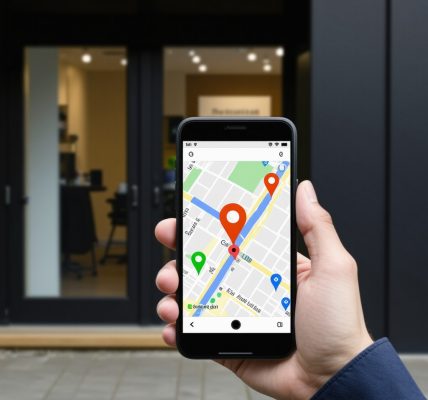Unlocking the Hidden Potential of Google Maps SEO for Your GMB Traffic
In today’s hyperlocal digital landscape, simply claiming your Google My Business (GMB) listing isn’t enough to attract meaningful traffic. To truly dominate local search and elevate your business visibility, leveraging advanced Google Maps SEO tactics is essential. These strategies not only increase your GMB traffic but also convert casual searchers into loyal customers by enhancing your presence in the coveted local map pack.
Crafting a Magnetic GMB Profile: The Art of Strategic Optimization
At the core of boosting your GMB traffic lies meticulous optimization of your profile. Beyond basic business details, integrating relevant LSI keywords naturally into your business description, services, and posts can significantly enhance your local search relevance. For example, including hyperlocal terms like “best coffee shop in [Neighborhood]” or “24/7 emergency plumber near me” aligns your listing with common search queries, improving your chances to appear in Google Maps results.
Moreover, ensure your business categories are as specific as possible and regularly updated to reflect your offerings. Adding high-quality, geo-tagged photos and videos not only enriches user engagement but also signals activity and authenticity to Google’s algorithms.
Mastering Local Citations and NAP Consistency: The Cornerstone of Trust
One often overlooked yet critical component of Google Maps SEO is the management of local citations — mentions of your business name, address, and phone number (NAP) across the web. Consistency here is paramount. Discrepancies can confuse search engines and dilute your local authority.
Implement a robust citation strategy by auditing your existing listings and correcting any inconsistencies. Utilize authoritative citation sources and directories that are highly regarded in your industry to amplify your local SEO signals. This tactic is supported by Moz’s Local Search Ranking Factors study, which highlights citation accuracy as a key ranking influence (Moz Local Ranking Factors).
How Does Google’s Algorithm Evaluate Your GMB for Local Ranking?
Google’s local search algorithm evaluates three primary factors: relevance, distance, and prominence. Relevance measures how well your GMB listing matches the searcher’s query. Distance considers the proximity of your business to the searcher’s location, and prominence reflects your overall authority and reputation, including reviews and backlinks.
Optimizing your GMB to address these factors means enriching your profile with detailed information, leveraging localized keywords, and actively managing your customer reviews to build prominence. This triad ensures your listing is not only visible but compelling enough to attract and retain local customers.
Engage and Elevate: The Power of Review Generation and Interaction
Customer reviews are a trusted beacon for both Google and potential customers. A steady flow of authentic, positive reviews boosts your listing’s prominence and signals trustworthiness. Proactively encourage satisfied clients to leave detailed reviews and respond promptly to all feedback, demonstrating your commitment to customer satisfaction.
Incorporate review generation strategies aligned with best practices to avoid penalties while maximizing impact. For deeper insights, explore expert techniques on GMB review generation that can propel your business ahead.
Seize the Opportunity: Integrate Google Maps SEO with Your Broader Local Strategy
While Google Maps SEO is a powerful standalone tactic, its true strength emerges when integrated with comprehensive local SEO efforts. This includes website optimization, local content marketing, and strategic link building tailored to your geographic market.
For businesses eager to master this integration, resources like local business growth strategies using Google Business SEO provide actionable frameworks that align Google Maps optimization with broader marketing goals.
Ready to Skyrocket Your Local Visibility? Share Your Experiences and Join the Conversation!
Boosting GMB traffic using Google Maps SEO tactics isn’t just about technical tweaks; it’s about crafting a trusted, engaging local presence that resonates with your community. Have you tried any innovative Google Maps SEO techniques that yielded surprising results? Share your story or questions below to enrich our shared expertise and help local businesses thrive.
Leveraging Google Posts and Q&A for Dynamic GMB Engagement
Google Posts and the Questions & Answers (Q&A) feature within your Google My Business profile offer untapped opportunities to actively engage potential customers and boost your local SEO. Regularly publishing timely, keyword-rich Google Posts about promotions, events, or news helps keep your listing fresh and signals to Google that your business is active and relevant. Similarly, proactively monitoring and responding to questions in the Q&A section not only improves user experience but also allows you to incorporate important keywords and address common customer concerns.
Experts recommend crafting Google Posts with clear calls to action and geo-specific keywords to maximize the impact on local search rankings. Additionally, using the Q&A section as a mini FAQ can preemptively answer prospects’ queries, reducing friction and improving conversions.
Harnessing the Power of Geo-Targeted Backlinks for Local Dominance
Backlinks from authoritative, locally relevant websites remain a critical factor for enhancing your Google Maps ranking. Establishing relationships with local business directories, community blogs, and chambers of commerce can generate valuable backlinks that boost your listing’s prominence. These geo-targeted backlinks help Google associate your business with a specific location, reinforcing your local relevance.
Securing backlinks through guest posts, sponsorships, or partnerships with local influencers can also drive referral traffic and increase brand awareness. A strategic backlink profile complements on-page optimization and citation consistency, creating a holistic local SEO ecosystem.
How Can Voice Search Optimization Influence Your Google Maps Ranking?
With voice search usage growing exponentially, optimizing your GMB listing for voice queries is becoming a crucial aspect of Google Maps SEO. Voice searches tend to be more conversational and question-based, often including phrases like “near me” or direct requests such as “where can I find the best pizza nearby?”.
To capitalize on this trend, integrate natural language keywords and long-tail questions into your GMB description, posts, and FAQs. Structured data markup on your website, combined with a fully optimized GMB profile, enhances your chances of being featured in voice search results, thus increasing your local visibility and traffic.
Tracking and Analyzing GMB Performance: Key Metrics You Can’t Ignore
Understanding how your Google My Business profile performs is vital for continuous improvement. Key metrics include the number of views on your listing, clicks to your website, direction requests, phone calls, and customer actions derived from Google Maps. Leveraging Google’s Insights and third-party analytics tools allows you to identify which optimization strategies yield the best ROI.
Regularly reviewing this data helps pinpoint opportunities to refine your content, adjust your keyword focus, and enhance user engagement techniques. For a comprehensive audit approach, consider tools and methodologies outlined in GMB SEO Audit: Improve Your Local Search Performance.
Integrating Schema Markup to Boost Local Search Signals
Schema markup is a structured data vocabulary that helps search engines better understand your website content and relate it to your GMB listing. Implementing LocalBusiness schema with detailed business information such as address, phone number, opening hours, and geo-coordinates can strengthen your local SEO performance.
This technical enhancement can improve rich snippet eligibility, making your business stand out in search results with enhanced visuals and information. This increased clarity boosts click-through rates and user trust, indirectly feeding into higher Google Maps rankings.
According to Search Engine Journal, businesses that implement schema markup see improved local visibility and engagement (Search Engine Journal: Schema Markup Guide).
What Are the Most Effective GMB Optimization Techniques for Multi-Location Businesses?
Multi-location businesses face unique challenges in maintaining consistent and optimized Google My Business profiles across all sites. Key tactics include creating distinct listings for each location with unique descriptions and localized keywords, ensuring NAP consistency, and managing reviews individually to reflect each store’s reputation.
Advanced strategies involve leveraging bulk location management tools and tailoring Google Posts and offers per location to address local customer needs. Integrating local landing pages on your website that correspond with each GMB listing further reinforces local relevance and improves search rankings.
Explore more in-depth multi-location GMB optimization strategies at Mastering Google Business SEO: Your Complete Guide.
Engage with us: If you found these insights valuable, consider sharing this post with your network or leaving a comment below about your experience optimizing Google Maps SEO. For deeper dives into local SEO tactics, explore our extensive guides and actionable tips across the site.
Unlocking the Power of User-Generated Content to Amplify Google Maps SEO Impact
One of the most sophisticated yet underutilized tactics in Google Maps SEO is the strategic incorporation of user-generated content (UGC). This includes photos, videos, reviews, and even social media mentions that your customers create organically. Google’s algorithm highly values authentic, fresh content linked to your GMB profile, as it signals active engagement and trustworthiness.
Encouraging customers to share their experiences through multimedia content not only enhances your listing’s appeal but also diversifies your keyword footprint with natural language and hyperlocal references. Implementing campaigns that incentivize UGC—such as photo contests or hashtag promotions aligned with your brand—can accelerate this process. Integrating UGC into your GMB posts and website galleries further reinforces your local relevance and enriches the customer journey.
Harnessing AI-Driven Analytics to Refine Google Maps SEO Strategies
Emerging AI-driven analytics tools now enable local businesses to gain unprecedented insights into user behavior on their GMB profiles. These platforms analyze search queries, interaction patterns, and competitor performance, providing actionable recommendations tailored to your local market niche.
By leveraging machine learning algorithms, you can identify which keywords yield the highest conversion rates, optimal posting times for Google Posts, and even predict trends in customer questions within the Q&A section. This granular data empowers you to dynamically adjust your optimization tactics and stay ahead of evolving Google Maps SEO algorithms.
How Can Integrating User Intent Data Elevate Your Google Maps SEO Performance?
Understanding user intent behind local searches is vital for crafting compelling GMB content that converts. Advanced analytics tools dissect query nuances—distinguishing between informational, navigational, and transactional intents—and help tailor your profile’s messaging accordingly.
For instance, a user searching for “best vegan bakery near me” has a different intent than one seeking “vegan bakery menu.” Aligning your GMB description, services, and posts with these varying intents ensures your listing resonates precisely with potential customers’ needs, enhancing click-through and engagement rates.
As highlighted by BrightLocal’s 2023 Local Consumer Review Survey, businesses that effectively address user intent see up to a 30% increase in customer actions via Google Maps (BrightLocal Local Consumer Review Survey 2023).

Implementing Hyperlocal Content Strategies to Complement Google Maps SEO
Beyond your GMB profile, creating hyperlocal content on your website and social channels can dramatically amplify your presence in Google Maps. This includes publishing blog posts, event announcements, and community news that incorporate neighborhood-specific keywords and landmarks.
Such content signals to Google that your business is deeply embedded within the local community, which in turn strengthens your GMB listing’s prominence and relevance. Furthermore, collaborating with local influencers or organizations to co-create content can generate valuable backlinks and enhance your authority.
What Are the Best Practices for Leveraging Google Maps SEO in Competitive Urban Markets?
Competitive urban markets demand precision and innovation. Beyond standard optimization, focus on micro-moment targeting—capturing the “I-want-to-go” or “I-want-to-buy” moments through tailored Google Posts and time-sensitive offers. Utilize location-based behavioral data to customize your messaging and promotions.
Investing in advanced local rank tracking tools helps monitor shifts in your placement within the local map pack, enabling swift adjustments. Also, prioritize mobile optimization since urban consumers increasingly rely on smartphones for local searches.
For an in-depth exploration of these advanced tactics, visit Advanced Google Maps SEO Strategies.
Engage with Us for Tailored Google Maps SEO Solutions
Are you ready to elevate your Google Maps SEO with cutting-edge techniques that integrate AI insights and hyperlocal engagement? Share your challenges or success stories in the comments below, and explore our expert guides for customized strategies designed to dominate your local market.
Augmenting Google Maps SEO with Predictive AI Insights for Local Market Supremacy
Incorporating artificial intelligence into your Google Maps SEO strategy transcends traditional optimization, enabling predictive adjustments that anticipate market fluctuations and consumer behavior shifts. AI-driven platforms analyze vast datasets, including competitor movements, seasonal demand variations, and user engagement trends, to deliver bespoke recommendations that refine your GMB profile and local digital footprint.
Such granular intelligence facilitates proactive content scheduling, keyword targeting aligned with emerging search patterns, and dynamic review solicitation strategies that adapt to customer sentiment analysis in real time. This continuous feedback loop ensures your Google Maps presence remains agile and competitively poised.
Strategic Utilization of Hyperlocal Video Content to Amplify Engagement and Rankings
Video content embedded within your GMB profile and local channels acts as a powerful engagement catalyst. Crafting hyperlocal video narratives that showcase your business environment, team introductions, and community involvement not only humanizes your brand but also exploits Google’s preference for rich media, facilitating higher ranking potential.
Optimizing these videos with geo-specific metadata, captions, and transcriptions further enhances discoverability. Additionally, integrating customer-generated video testimonials can exponentially increase trust signals and dwell time, both critical metrics for local search prominence.
How Can Leveraging Sentiment Analysis Enhance Your GMB Review Management Strategy?
Sentiment analysis tools dissect customer reviews to categorize feedback into positive, neutral, or negative sentiments, uncovering nuanced insights beyond star ratings. Employing this technology enables businesses to promptly address emerging issues, tailor responses that resonate authentically, and identify features or services that delight customers.
This strategic approach not only bolsters your reputation management but also informs targeted improvements that directly impact your Google Maps ranking by elevating your prominence and trustworthiness.
For further expertise, the Moz Local Search blog provides comprehensive analyses on sentiment-driven review strategies (Moz: Local SEO Review Sentiment Analysis).
Call to Action: Harness These Advanced Google Maps SEO Techniques Today
Elevate your local search dominance by integrating AI analytics and hyperlocal multimedia strategies into your Google Maps SEO efforts. Begin experimenting with predictive tools and dynamic content creation to outpace competitors and captivate your community with authentic engagement. Share your experiences or challenges with these cutting-edge methods in the comments below and join an expert network committed to pioneering local SEO excellence.
Frequently Asked Questions (FAQ)
What is Google Maps SEO and why is it important for local businesses?
Google Maps SEO refers to the optimization of your Google My Business (GMB) listing and associated digital assets to improve visibility in Google Maps local search results. It is crucial for local businesses because it directly influences how easily potential customers find your business when searching for products or services nearby, driving increased foot traffic and conversions.
How can I ensure my Google My Business profile is fully optimized?
To optimize your GMB profile, provide comprehensive and accurate business information, select specific and relevant categories, integrate localized and LSI keywords naturally into descriptions and posts, upload high-quality geo-tagged photos and videos, and actively manage customer reviews and Q&A sections. Regular updates and engagement signal activity and relevance to Google’s algorithms.
Why is NAP consistency critical in Google Maps SEO?
NAP consistency—having your business Name, Address, and Phone number uniform across all online platforms and citations—is fundamental because discrepancies confuse search engines and reduce your local authority. Consistent citations enhance trustworthiness, contributing to higher local search rankings.
How does customer review management impact my Google Maps ranking?
Customer reviews influence your business’s prominence and trust signals in Google’s local algorithm. Encouraging authentic positive reviews, responding promptly and thoughtfully to feedback, and utilizing sentiment analysis tools to manage reputation can significantly enhance your ranking and customer perception.
What role do backlinks play in improving my Google Maps SEO?
Backlinks from authoritative and locally relevant websites reinforce your business’s prominence and geographic relevance, boosting your GMB ranking. Strategies include obtaining links from local directories, community organizations, influencers, and guest posting on reputable local platforms.
How can I optimize my GMB listing for voice search?
Voice search optimization involves incorporating natural language, conversational long-tail keywords, and question-based phrases into your GMB description, posts, and FAQs. Structured data markup on your website also helps search engines better understand and feature your business in voice search results.
What metrics should I track to measure the effectiveness of my Google Maps SEO efforts?
Key metrics include listing views, website clicks, direction requests, phone calls, and customer engagement actions from Google Maps. Utilizing Google Insights along with third-party analytics tools allows you to analyze performance and refine strategies for better ROI.
How can multi-location businesses effectively manage GMB optimization?
Multi-location businesses should create distinct GMB listings for each site with unique localized content, maintain consistent NAP data, manage reviews per location, and use bulk location management tools. Complementary local landing pages on the main website tied to each location further enhance local relevance.
What is the benefit of integrating AI-driven analytics into Google Maps SEO?
AI-driven analytics provide granular insights into user behavior, search intent, and competitor strategies, enabling predictive and dynamic optimization of your GMB profile. This helps tailor content, keyword targeting, and engagement tactics for maximum local impact and sustained competitive advantage.
How does user-generated content enhance my Google Maps SEO?
User-generated content such as customer photos, videos, and reviews adds authentic, fresh, and diverse content to your GMB profile, signaling active engagement and trustworthiness to Google. Campaigns that encourage UGC can drive higher local relevance and improve search rankings.
Trusted External Sources
- Moz Local Search Ranking Factors – This comprehensive study provides detailed insights into the ranking influences affecting local SEO, including citations and review management, foundational for optimizing Google Maps listings.
- BrightLocal Local Consumer Review Survey 2023 – Offers in-depth analysis of consumer behavior relating to local business reviews and illustrates how understanding user intent can increase customer actions via Google Maps.
- Search Engine Journal: Schema Markup Guide – An authoritative resource on implementing schema markup to enhance local SEO signals and improve visibility through rich snippets on search result pages.
- Moz: Local SEO Review Sentiment Analysis – Provides expert guidance on leveraging sentiment analysis tools to elevate reputation management and Google Maps ranking through strategic review responses.
- Google My Business Help Center – Official documentation and best practices from Google on managing and optimizing your GMB profile, including features like Google Posts and Q&A.
Conclusion
Mastering Google Maps SEO is a multifaceted journey that requires a strategic blend of profile optimization, citation consistency, quality backlink acquisition, and dynamic engagement through reviews, posts, and user-generated content. By integrating advanced tactics such as AI-driven analytics, voice search optimization, and hyperlocal content strategies, businesses can significantly enhance their local search prominence and attract targeted traffic. Understanding and addressing user intent, leveraging rich media, and maintaining active community interaction are pivotal to sustaining competitive advantage in the evolving local search landscape.
Embracing these comprehensive approaches to Google Maps SEO not only elevates your Google My Business traffic but also fosters trust and loyalty within your community. Start applying these expert insights today, share your experiences, and continue exploring our specialized content to stay at the forefront of local SEO excellence.



